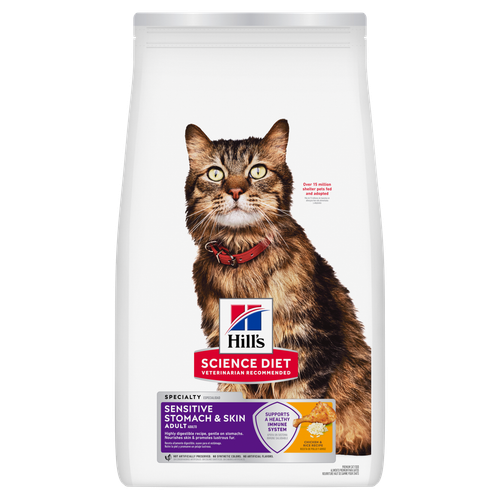
-
Find the right food for your petTake this quiz to see which food may be the best for your furry friend.Find the right food for your petTake this quiz to see which food may be the best for your furry friend.Featured products
 Adult Chicken & Barley Recipe Dog Food
Adult Chicken & Barley Recipe Dog FoodSupports lean muscle and beautiful coat for adult dogs
Shop Now Adult Large Breed Chicken & Barley Recipe Dog Food
Adult Large Breed Chicken & Barley Recipe Dog FoodSupports healthy joints, lean muscle, and beautiful coat for large breed dogs
Shop Now Hill's Science Diet Adult Chicken & Beef Entrée Dog Food
Hill's Science Diet Adult Chicken & Beef Entrée Dog FoodChicken & Beef Entrée in a delicious loaf with complete & balanced nutrition to help keep adult dogs active and healthy
Shop NowFeatured products Adult 7+ Senior Vitality Chicken & Vegetable Stew Cat Food
Adult 7+ Senior Vitality Chicken & Vegetable Stew Cat FoodImproves Everyday Ability to Get Up & Go
Shop Now Hill's Science Diet Adult Sensitive Stomach & Skin Chicken & Rice Recipe Cat Food
Hill's Science Diet Adult Sensitive Stomach & Skin Chicken & Rice Recipe Cat FoodScience-backed nutrition tailored for skin and digestive health, packed with clinically proven, immune system supporting antioxidants.
Shop Now Adult Chicken Recipe Cat Food
Adult Chicken Recipe Cat FoodSupports lean muscle and beautiful fur for adult cats
Shop Now -
Dog
- Dog Tips & Articles
-
Health Category
- Weight
- Food & Environmental Sensitivities
- Urinary
- Digestive
- Joint
- Kidney
-
Life Stage
- Puppy Nutrition
- Adult Nutrition
- Senior Nutrition
Cat- Cat Tips & Articles
-
Health Category
- Weight
- Skin & Food Sensitivities
- Urinary
- Digestive
- Kidney
-
Life Stage
- Kitten Nutrition
- Adult Nutrition
Featured articles How to Properly Mix Wet & Dry Pet Foods
How to Properly Mix Wet & Dry Pet FoodsAn Orange cat eating from a bowl filled with mixed food
Read More The Science Behind Our Love for Pets
The Science Behind Our Love for PetsLearn the scientific reasons why we have such strong connections with our pets, and what science says about the love between humans and our furry friends.
Read More What Is Littermate Syndrome? Pet Adoption Guide
What Is Littermate Syndrome? Pet Adoption GuideLearn more about littermate syndrome in dogs and cats and how to successfully navigate adoption and early socialization processes.
Read More -


While you may take your cat or dog to the groomers from time to time, there's a good chance that you handle much of their nail trimming needs at home. But what happens if your pet pulls away as you're cutting their nails? If your cat or dog starts to bleed because you cut too much or a nail tears, you'll want to make sure you know how to provide first aid. In situations like these, having a container of styptic powder can really come in handy. But what is styptic powder, and how do you use it properly?
What Is Styptic Powder?
Styptic powder is an anti-hemorrhagic agent that stops light wounds from bleeding. Veterinarians, professional pet groomers and pet parents can use this powder on dogs, cats and even some birds.
Dr. Jim Carlson, owner of and holistic veterinarian at the Riverside Animal Clinic & Holistic Center, says, "The most popular formula for styptic powder contains ferric subsulfate which works to help clot blood, along with bentonite clay and aluminum sulfate. Some products contain different ingredients like diatomaceous earth as well."
Styptic powder can also come in stick form, although Dr. Carlson reports that when applied, the stick may "sting."

How to Use Styptic Powder
When you're cutting your pet's nails, keep the styptic powder nearby. You'll want to use it at the first sign of bleeding. The great news is that putting styptic powder on is relatively easy:
- First and foremost, clean any blood off of your pet's paws.
- Then, pinch some of the powder between your fingers.
- Finally, apply it to the affected area using light pressure.
You may also dip your pet's nail into a shallow dish with the powder and then apply a light pressure to the nail. Using the powder stick mentioned above is another option to stop bleeding.
After applying the powder, the bleeding should stop, and you won't need to do anything further. However, if it does not stop, contact your vet. Skip the styptic powder completely for heavy bleeds and instead head straight to your local emergency pet health center.


Tasty Tips
Young pets may need several visits in their first year for vaccinations. Adult pets generally benefit from annual check-ups, while senior or special-needs pets might require more frequent visits.
Should Styptic Powder Be Removed?
If you've never used styptic powder before, you might wonder if you should wash it off after some time. There is no need to remove the powder once the bleeding has stopped, though. In fact, removing it may even cause the wound to bleed again.
"You should leave the powder on your pet's nail and let it fall off gradually," says Dr. Carlson. "Keeping your pet quiet for a bit to ensure the bleeding has stopped is important. Too much activity right after it's on and the pet will begin to bleed again."
Can Styptic Powder Be Harmful?
Dogs and cats are known for licking themselves quite often, so what happens if they lick the styptic powder while it's on? Most likely, they'll be just fine. Ingesting just a small amount of styptic powder won't hurt your pet at all.
However, Dr. Carlson advises that pet parents keep the container of styptic powder out of reach for their pets and even children. The powder contains active ingredients — such as ferrous sulfate — which can cause upset stomach and even constipation once ingested.
If your cat or dog gets into a container of styptic powder, be sure to contact your vet as soon as possible.


Erin Ollila believes in the power of words and how a message can inform—and even transform—its intended audience. Her writing can be found all over the internet and in print, and includes interviews, ghostwriting, blog posts, and creative nonfiction. Erin is a geek for SEO and all things social media. She graduated from Fairfield University with an M.F.A. in Creative Writing. Reach out to her on Twitter @ReinventingErin or learn more about her at http://erinollila.com.
Related products

Chicken & Beef Entrée in a delicious loaf with complete & balanced nutrition to help keep adult dogs active and healthy

Chicken & Barley Entrée in a delicious loaf with great taste and precisely balanced nutrition to support 5 essential building blocks for lifelong health

Supports healthy joints, lean muscle, and beautiful coat for large breed dogs

Supports lean muscle and beautiful coat for adult dogs
Related articles

Learn more about littermate syndrome in dogs and cats and how to successfully navigate adoption and early socialization processes.

Understanding how to train puppies and kittens starts with understanding their differences. Discover tips for training success for puppies vs. kittens.

An Orange cat eating from a bowl filled with mixed food

Learn the scientific reasons why we have such strong connections with our pets, and what science says about the love between humans and our furry friends.

Put your pet on a diet without them knowing
Our low calorie formula helps you control your pet's weight. It's packed with high-quality protein for building lean muscles, and made with purposeful ingredients for a flavorful, nutritious meal. Clinically proven antioxidants, Vitamin C+E, help promote a healthy immune system.
Put your pet on a diet without them knowing
Our low calorie formula helps you control your pet's weight. It's packed with high-quality protein for building lean muscles, and made with purposeful ingredients for a flavorful, nutritious meal. Clinically proven antioxidants, Vitamin C+E, help promote a healthy immune system.

